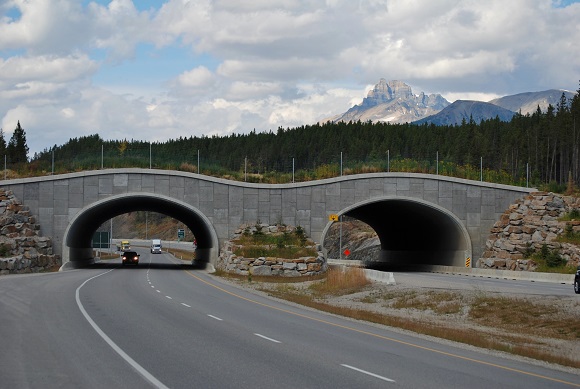
Wildlife Overpasses in Banff National Park
Updated June 2022
The Trans Canada Highway is a busy, four-lane route crossing Canada from coast to coast. Unfortunately, the highway passes through several national parks in the Rocky Mountains, and many animals were getting killed by traffic.
To solve this problem, bridges and tunnels were constructed to allow wildlife to cross the highway without danger. In addition, a fence was installed on both sides of the highway for the entire length of Banff National Park. This forces animals to use the bridges and underpasses.
The underpasses are simply tunnels under the road. You may not notice them as you drive through the park, but you will not miss the obvious overpasses. You will see a large bridge crossing the highway with grass and bushes growing on it and no roads leading up to it on either side. Most people must wonder what it is.
At first, the wildlife, especially bears, were reluctant to use the passes. But after five years, it was found that most animals in the park, including Grizzly Bears, are now using the overpasses and underpasses to cross the highway. As a result, wildlife collisions with vehicles in the park are now reduced by 80%. There are other roads in the parks beside the Trans Canada Highway where collisions still occur, although a lot less than on the Trans Canada. Sometimes a few animals still get onto the highway at intersections.
The wildlife overpasses and underpasses were completed in 2014. There are 38 underpasses and six overpasses in Banff National Park and some in Yoho National Park. Grizzly and Black bears, wolves, Coyotes, Cougars, Moose, Elk, Deer, Bighorn Sheep, Wolverine and Lynx, have been seen using the crossings. Elk were the first animals to use the wildlife crossings, while some animals, such as Grizzly Bears, took up to five years before they learned to trust them.
The wildlife overpasses cost up to four million dollars to build (the underpasses are much cheaper). Kudos to the Canadian Government for spending this money to protect our wildlife in the National Parks.
Hunting in Parks
I cannot say the same for most Provincial Parks in Canada. While doing wildlife photography in a Provincial Park in Manitoba, I was surprised to come across a group of bear hunters. Canada is a big place, and there are plenty of places for hunting, yet provinces allow hunting within their provincial parks (within specific park regulations). In some places, it is even allowed to put out bait to lure animals in to be shot. This is done for the fees gained from licences.
Aside from disagreeing with this policy, I was worried about being mistaken for a bear and shot. I felt that is not safe to be in the park during the bear-hunting season. Not only was hunting allowed, but it also discouraged other people from using the park. Thankfully, this happens only in the Provincial Parks and is strictly prohibited in the National Parks.
Hunting in Provincial Parks is not only for bears but for many species of wildlife.
The Merriam-Webster dictionary defines a park as public land kept in its natural state to protect plants and animals. (Apart from city parks and other recreation areas). It also should be open to the public to enjoy, but not harm, these assets. In the National Parks, it is illegal to harm or feed any animal or cut any plant.
Moose hunting is allowed in National Parks in the province of Newfoundland because the Moose is not an indigenous animal to the island. Humans introduced them and the population has exploded to such an extent that they have become a danger to vehicle traffic instead of traffic being a danger to wildlife as in the rest of Canada. There are no natural predators for Moose in Newfoundland. Also, an overpopulation of Moose will cause severe damage to plant life. After a decade of this program, the forest is beginning to recover from overbrowsing. A hunting licence in these parks is for Moose only. No other species may be shot.
Canada’s National Parks are wonderful places to explore nature and see spectacular scenery. Activities include hiking, camping, photography, birding and the most popular one – seeing some of the many large mammals that inhabit the parks.